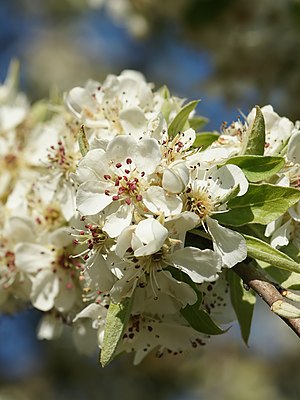ἄχερδος: Difference between revisions
ἀλλὰ σὺ μὲν νῦν στῆθι καὶ ἄμπνυε → but you, stop now and catch your breath | but do thou now stand, and get thy breath
mNo edit summary |
|||
| Line 9: | Line 9: | ||
|Beta Code=a)/xerdos | |Beta Code=a)/xerdos | ||
|Definition=[ᾰ], ἡ (less freq. ὁ, Theoc.24.90), [[wild pear]], [[Pyrus amygdaliformis]], Od.14.10, [[Sophocles|S.]]''[[Oedipus Coloneus|OC]]''1596, Pherecyd.33 J., Theoc. [[l.c.]]; ἀ. τῆς ἀκραχολωτάτης Pherecr. 164: special kind at Ceos, Arist.''Mir.''845a15. | |Definition=[ᾰ], ἡ (less freq. ὁ, Theoc.24.90), [[wild pear]], [[Pyrus amygdaliformis]], Od.14.10, [[Sophocles|S.]]''[[Oedipus Coloneus|OC]]''1596, Pherecyd.33 J., Theoc. [[l.c.]]; ἀ. τῆς ἀκραχολωτάτης Pherecr. 164: special kind at Ceos, Arist.''Mir.''845a15. | ||
}} | |||
{{wkpen | |||
|wketx=[[File:Pyrus amygdaliformis (flowers).jpg|thumb|Pyrus amygdaliformis (flowers)]] [[Pyrus spinosa]] (syn. [[Pyrus amygdaliformis]]), the [[almond-leaved pear]], is a species of flowering plant in the family Rosaceae, native to the northern Mediterranean region. It grows to a height of 3–10 m (10–33 ft). It has white flowers which bloom in April–May. The fruits are bitter and astringent. It hybridizes easily with Pyrus communis and Pyrus pyraster. | |||
}} | }} | ||
{{DGE | {{DGE | ||
Latest revision as of 15:54, 22 December 2024
English (LSJ)
[ᾰ], ἡ (less freq. ὁ, Theoc.24.90), wild pear, Pyrus amygdaliformis, Od.14.10, S.OC1596, Pherecyd.33 J., Theoc. l.c.; ἀ. τῆς ἀκραχολωτάτης Pherecr. 164: special kind at Ceos, Arist.Mir.845a15.
Wikipedia EN
Pyrus spinosa (syn. Pyrus amygdaliformis), the almond-leaved pear, is a species of flowering plant in the family Rosaceae, native to the northern Mediterranean region. It grows to a height of 3–10 m (10–33 ft). It has white flowers which bloom in April–May. The fruits are bitter and astringent. It hybridizes easily with Pyrus communis and Pyrus pyraster.
Spanish (DGE)
-ου, ἡ
• Prosodia: [ᾰ-]
• Morfología: [ὁ ἄ. Theoc.24.90]
bot. peral silvestre, Pyrus amygdaliformis Vill. (αὐλήν) ἐθρίγκωσεν ἀχέρδῳ Od.14.10, cf. S.OC 1596, Pherecyd.33, Pherecr.174, Call.SHell.257.15, Theoc.24.90, Arist.Mir.845a15, AP 7.536 (Alc.Mess.), A.D.Adu.152.15, Coni.256.27, Nonn.D.14.369, Hsch.
German (Pape)
[Seite 417] ἡ, auch ὁ, Hagedorn, ein wilder dorniger Strauch, zu Hecken gebraucht, Od. 14, 10, ἅπαξ εἰρημ.; Alc. Mess. 18 (VII, 536) πνιγόεις; vgl. Theocr. 24, 88; Soph. O. C. 1592 = wilder Birnbaum, vgl. Phereer. B. A. 475 u. s. ἀχράς.
French (Bailly abrégé)
ου (ἡ, rar. ὁ)
1 arbuste épineux;
2 poirier sauvage.
Étymologie: DELG étym. ignorée ; pê terme local, cf. ἀχράς.
Par. ἀχράς, ἄπιος.
Russian (Dvoretsky)
ἄχερδος: ἡ, у Theocr. ὁ
1 предполож. дикая груша (Pirus salicifolia) Soph., Theocr., Arst.;
2 живая изгородь (θρινκοῦν ἀχερδῳ Hom.).
Greek (Liddell-Scott)
ἄχερδος: ἡ, σπανιώτερον ὁ (Θεόκρ. 24. 88)· ἄγριός τις ἀκανθώδης θάμνος, ὃν μετεχειρίζοντο πρὸς κατασκευὴν φρακτῶν, ἴσως εἶδος ἀγρίας ἀχράδος, ἀγριαπιδιᾶς, Ὀδ. Ξ. 10, Σοφ. Ο. Κ. 1596, Φερεκρ. ἐν Ἀδήλ. 32.
English (Autenrieth)
wild pear-tree, prickly pear, Od. 14.10†.
Greek Monolingual
ἄχερδος, ο, η (Α)
είδος άγριας αχλαδιάς, αγριαπιδιά.
[ΕΤΥΜΟΛ. Άγνωστης ετυμολ. Έχει υποτεθεί ότι συνδέεται με αλβ. darδe «αχλάδι» ή ότι ανάγεται σε ινδοευρ, ĝher(s)- «υψώνομαι, εξέχω», μέσω μιας σημασιολογικής εξελίξεως («αγκαθωτοί θάμνοι» > «άγρια αχλαδιά»), η οποία δεν είναι πειστική. Πρόκειται μάλλον για επιτόπια λέξη που σχετίζεται πιθ. με το πιο εύχρηστο αχράς].
Greek Monotonic
ἄχερδος: ἡ, άγριος αγκαθωτός θάμνος, άγρια αχλαδιά, αγριαπιδιά, σε Ομήρ. Οδ., Σοφ.· αρσ. σε Θεόκρ. (άγν. προέλ.).
Frisk Etymological English
Grammatical information: f. (m. Theoc.)
Meaning: wild pear, Pyrus amygdaliformis (Od.).
Other forms: ἀγέρδα (cod. -αα)· ἄπιος, ὄγχνη H. ἄχηρον· ἀκρίδα Κρῆτες H., with Cretan ερδ > ηρ; ἀκρίδα is changed by Latte into ἀχράδα; doubtful; cf. ἀκρίς.
Origin: PG [a word of Pre-Greek origin]
Etymology: See Chantr. Form. 359. - ἀγέρδα can be Macedonian; if not, the variation shows a Pre-Gr. word. Jokl, Festschrift Kretschmer 89ff., derived it from *ǵher(s)- stretch (WP. 1, 610; Pok. 445f.) assuming a development thornbush > wild pear; the ἀ- would be copulative; both quite improbable. Comprared with Alb. dardhë pear (*ghord-). The ἀ- must then be a real prothesis and the word a non-IE loan word. Connection with ἀχράς is evident; q.v.
Middle Liddell
[Deriv. unknown.]
a wild prickly shrub, a wild pear, Od., Soph.; masc. in Theocr.
Frisk Etymology German
ἄχερδος: {ákherdos}
Grammar: f. (m.)
Meaning: wilder Birnbaum, Pyrus amygdaliformis (Od., S., Theok. usw.).
Etymology: Zur Bildung Chantraine Formation 359, Schwyzer 508. — Nicht sicher erklärt. Von Bugge BB 18, 184 und Mann Lang. 28, 34 mit alb. darδe Birne verglichen; von Jokl Festschrift Kretschmer 89ff. weiterhin zu idg. ĝher(s)- starren (WP. 1, 610; Pok. 445f.) gezogen unter der ganz hypothetischen Annahme einer Bedeutungsentwicklung Dorngebüsch > wilder Birnbaum. Anlaut ἀ- wäre kopulativ. — Älterer Versuch bei WP. 1, 608 und Bq s. ἀχράς; vgl. d. W. S. auch Schrader-Nehring Reallex. 147.
Page 1,199

